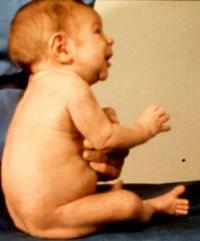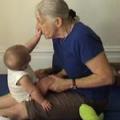Different development
Premature infants and infants with joint hypermobility, low muscle tone, breech delivery and a stressful newborn period often follow a different developmental pathway. They may be achieve one or more of the major motor milestones of rolling, sitting, crawling and walking later than usual the ages provided by motor milestone charts.
This can be unnecessarily upsetting for parents because milestone charts are based on averages and do not reflect the wide variety in the ages that infants learn to roll, sit, crawl and walk. It is also important for parents to know that premature infants will often achieve sitting, crawling and walking a month or two later even when using corrected age. Infants with joint hypermobility, low muscle tone, breech birth, plagiocephaly and torticollis and other musculoskeletal differences may also take their time to learn to sit, crawl and walk.
Development is a journey
Development of gross motor skills can be seen as a journey along four different paths, each one with several stepping stones leading to the major milestones of rolling, sitting independently, crawling and walking.
Each infant travels along these different pathways at their own particular pace, negotiating his or her way over and around the stepping stones to complete the journey. Each stepping stone represents a new skill that needs to be mastered.


It is important to know that some infants may travel rapidly along one pathway and be slower on another pathway. An infant may start to crawl quite early but be slow to learn to walk. Some infant's will start to stand and cruise before they learn to crawl.


Why track your infant's progress over the stepping stones?
Each stepping stone represents a new level of control, coordination and strength which allows the infant to move forwards towards the next stepping stone.
Tracking your infant's progress across the stepping stones is a good way to know that your infant is moving steadily over the stepping stones and is on the way to achieving a milestone.
Sometimes an infant's developmental progress seems to get stuck. They appear to reach a barrier which stops them from moving on to the next level of skill. This often means that the infant requires extra work to improve the control, coordination strength and flexibility needed for moving on. When this happens it helps to know what to do to help your infant to progress.
Milestones and premature infants
Remember to use your premature infant's corrected age when tracking progress.
It is also important to remember that premature infants tend to be a little slower at learning to sit, crawl and walk, often being 1-2 months slower than most typically developing infants even when using the corrected age.
Milestones and joint hypermobility/low muscle tone
Hypermobile infants, especially those with a cautious nature also tend to take longer to learn to crawl and walk. This is often associated with muscle weakness and tightness which hinders their attempts to lift themselves up against gravity.
Track gross motor progress along the different pathways




